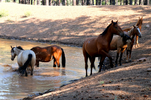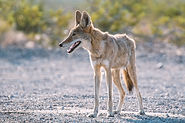Mule Deer
Odocoileus hemionus

Look in open meadows at dawn/dusk
Mule deer are a common and adaptable species found throughout Arizona’s forests, woodlands, and open meadows. Named for their large, mule-like ears, they are easily recognized by their gray-brown coats and white rump patches. Mule deer are most often seen along forest edges, meadows, and roadsides, where they browse on shrubs, grasses, and seasonal vegetation. They are crepuscular, most active at dawn and dusk, and travel in small groups or family units. Bucks grow branching antlers that are shed and regrown annually, while does focus on raising fawns in sheltered areas. As a widespread and visible species, mule deer are an integral part of Arizona’s ecosystems, providing prey for predators and helping shape vegetation patterns through their browsing habits.
Mammal

Identification & Behavior
Key Features: Large ears, white rump patch, forked antlers in males
Size: 3–3.5 ft tall, 125–300 lbs
Behavior: Form small groups; bucks grow antlers each year
Diet: Herbivore —grasses, shrubs, forbs
Activity Pattern: Crepuscular
Habitat & Distribution
Distributed statewide in forests, woodlands, high desert, and riparian corridors. Common along the Mogollon Rim, Kaibab Plateau, White Mountains, and Prescott Highlands. Present in Kaibab, Coconino, Apache-Sitgreaves, Prescott, and Tonto National Forests.
Elevation Range: 4,000–9,000 ft
Seasonal Presence: Year-round
Risks & Management
Give space; males can be aggressive during rut









































